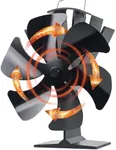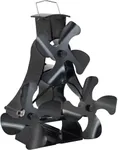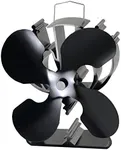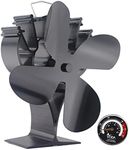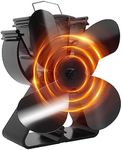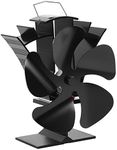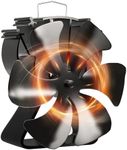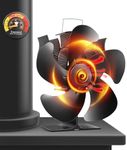Buying Guide for the Best Wood Stove Fan
Choosing a wood stove fan can make a big difference in how efficiently your stove heats your space. These fans help circulate warm air throughout the room, making your heating more effective and comfortable. When picking a wood stove fan, it's important to understand the key features that affect performance, durability, and ease of use. By focusing on the main specifications, you can find a fan that matches your stove, room size, and personal preferences.Power SourceThe power source of a wood stove fan determines how it operates. Most wood stove fans are either thermoelectric (powered by the heat of the stove) or battery/electric powered. Thermoelectric fans are popular because they don't require any external power and start working as soon as the stove heats up. Battery or electric fans may offer more consistent airflow but need a power supply. If you want a fan that works automatically with your stove and doesn't add to your energy bills, a thermoelectric model is a good choice. If you need more control or have a larger space, you might consider a powered option.
Airflow (CFM)Airflow, measured in cubic feet per minute (CFM), tells you how much air the fan can move. Higher CFM means more air is circulated, which can help heat larger rooms more quickly. Fans with lower CFM (under 150) are suitable for small rooms or if you want gentle air movement. Medium CFM (150-250) works well for average-sized living spaces, while high CFM (over 250) is best for large or open areas. Think about the size of the room you want to heat and choose a fan with an airflow rating that matches your needs.
Operating Temperature RangeThe operating temperature range tells you the minimum and maximum stove surface temperatures at which the fan works safely and efficiently. Some fans start spinning at lower temperatures (around 120°F/50°C), while others need the stove to be hotter. The maximum temperature is also important—if your stove gets hotter than the fan can handle, it could get damaged. Check your stove's typical surface temperature and pick a fan that starts working at a similar or lower temperature, and can handle the highest heat your stove produces.
Number of BladesThe number of blades on a wood stove fan affects how much air it can move and how quietly it operates. Fans usually have between two and five blades. Fewer blades often mean a quieter fan with a gentler airflow, while more blades can move more air but may be a bit noisier. If you want a balance between quiet operation and good air movement, a three- or four-blade fan is a common choice. Consider your sensitivity to noise and how much air movement you want when deciding.
Material and Build QualityThe material and build quality of the fan affect its durability and performance. Most wood stove fans are made from metal, such as aluminum or steel, which can withstand high temperatures. Some may have plastic parts, but these are less durable. A well-built metal fan will last longer and handle the heat better. If you use your stove frequently or want a fan that will last for years, look for one with sturdy construction and quality materials.
Size and PlacementThe size of the fan should match the available space on your stove and the area you want to heat. Larger fans can move more air but need more room on the stove surface. Make sure the fan fits comfortably on your stove without blocking access or interfering with other items. Also, consider the recommended placement—some fans work best at the back or side of the stove. Measure your stove surface and check the fan's dimensions to ensure a good fit.
